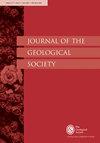青藏高原中部伦坡拉盆地晚渐新世季风气候:来自古土壤记录的证据
IF 3
3区 地球科学
Q2 GEOSCIENCES, MULTIDISCIPLINARY
引用次数: 0
摘要
亚洲季风影响着中国的自然环境气候模式,其起源和演变一直是古气候学中争论不休的问题。最近的研究结果表明,亚洲季风至少在~ 41 Ma到达亚热带,并在晚渐新世期间扩展到青藏高原中部,但其时空演变仍需要更多的地质证据来证实。青藏高原中部伦坡拉盆地发育良好的晚渐新世古土壤是解决这一问题的理想材料。各种气候指标的观测表明,这些古土壤为森林褐土,表现为Bt和Bk复合层位、丰富的粘土包覆层和碳酸盐结核,以及Bt层位的诊断性粘土化学成分。较高的CIA值、Rb/Sr比值和伊利石/蒙脱石混合层矿物的高含量表明古土壤经历了强烈的风化和淋溶成土作用。根据经验公式估算,古土壤发育时期的年平均气温为10.4 ~ 14.8℃,年平均降水量为615 ~ 1128 mm,与季风气候下的肉桂土参数相当。该研究为研究亚洲季风演化提供了重要的古土壤独立证据。专题文集:本文是中生代和新生代构造、景观和气候变化文集的一部分,可在:https://www.lyellcollection.org/topic/collections/mesozoic-and-cenozoic-tectonics-landscape-and-climate-change获取补充资料:https://doi.org/10.6084/m9.figshare.c.6850703本文章由计算机程序翻译,如有差异,请以英文原文为准。
Late Oligocene monsoonal climate in the Lunpola Basin, central Tibetan Plateau: evidence from paleosol records
The Asian monsoon affects the natural environmental climate pattern in China, and its origin and evolution have been a debated issue in paleoclimatology. Results from recent studies indicate the Asian monsoon reached the subtropical zone at least ∼ 41 Ma and expanded to the central Tibetan Plateau during the Late Oligocene, but more geological evidence is still required to confirm its spatial and temporal evolution. The well-developed Late Oligocene paleosol in the Lunpola Basin, central TP, is ideal material for addressing the issue. In this paper, observations of various climatic indicators suggest these paleosols were forest cinnamon soils, shown by the compound Bt and Bk horizons, abundant clay coating and carbonate nodules, and diagnostic clay chemical composition in Bt horizons. High CIA values, Rb/Sr ratios, and high contents of illite/smectite mixed layer minerals show paleosols experienced intense weathering and leaching pedogenesis. Furthermore, the mean annual temperature and mean annual precipitation during the paleosol developmental period were 10.4∼14.8 ℃ and 615∼1128 mm, respectively, as estimated by the empirical formulas, which are comparable to the parameters of cinnamon soils in monsoon climate. This study provides important independent evidence of paleosol for the study of the evolution of the Asian monsoon. Thematic collection: This article is part of the Mesozoic and Cenozoic tectonics, landscape and climate change collection available at: https://www.lyellcollection.org/topic/collections/mesozoic-and-cenozoic-tectonics-landscape-and-climate-change Supplementary material: https://doi.org/10.6084/m9.figshare.c.6850703
求助全文
通过发布文献求助,成功后即可免费获取论文全文。
去求助
来源期刊

Journal of the Geological Society
地学-地球科学综合
CiteScore
6.00
自引率
3.70%
发文量
68
审稿时长
6-12 weeks
期刊介绍:
Journal of the Geological Society (JGS) is owned and published by the Geological Society of London.
JGS publishes topical, high-quality recent research across the full range of Earth Sciences. Papers are interdisciplinary in nature and emphasize the development of an understanding of fundamental geological processes. Broad interest articles that refer to regional studies, but which extend beyond their geographical context are also welcomed.
Each year JGS presents the ‘JGS Early Career Award'' for papers published in the journal, which rewards the writing of well-written, exciting papers from early career geologists.
The journal publishes research and invited review articles, discussion papers and thematic sets.
 求助内容:
求助内容: 应助结果提醒方式:
应助结果提醒方式:


